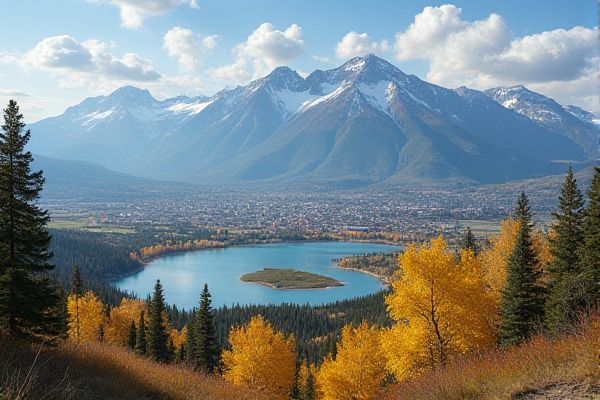
Insights from Montana residents and expatriate communities: Weather and climate variations. Cost of living comparisons. Employment opportunities and industries. Outdoor recreation options. Community culture and lifestyle. Transportation and infrastructure. Education quality and school systems. Healthcare facilities accessibility. Property and housing market trends. Local wildlife and nature awareness.
Weather and climate variations.
Montana residents experience highly variable weather with significant temperature fluctuations, a dry climate, and ample sunshine. The state's climate varies greatly by season and region, with spring bringing unpredictable storms, summer characterized by dry and hot conditions with occasional thunderstorms, and autumn marked by transitional weather that can include early winter storms. The state's diverse geography leads to large regional variations in climate, with warming trends evident, particularly in winter. Residents face increased risks of droughts, wildfires, and extreme temperature changes, including the impact of chinook winds that can cause dramatic temperature shifts. For more detailed information, you can visit the Montana Angler website.
Cost of living comparisons.
The cost of living in Montana is 1.09 times less expensive than the national average in the United States, with a total monthly cost for one person of $2030, including rent, utilities, food, and other expenses. Housing and utilities are significant costs, with a one-bedroom apartment in the city center averaging $1210 per month. While other expenses like food and transportation are relatively lower compared to national averages, the detailed breakdown can be found on the Living Cost website.
Employment opportunities and industries.
Montana's employment landscape is dominated by the service sector, with significant job concentrations in urban centers like Billings, Bozeman, and Missoula. Key growth industries include healthcare, which has added nearly 20,000 jobs, and technology, particularly in Bozeman. Meanwhile, rural areas face challenges with lower wages and fewer job opportunities. For a more in-depth look at the state's economic dynamics, visit the Montana Free Press.
Outdoor recreation options.
Montana is a haven for outdoor enthusiasts, offering a plethora of activities amidst its stunning natural landscapes. Around Missoula, one can indulge in exhilarating outdoor recreation such as whitewater rafting, skiing, bird watching, camping, and more. For those interested in combining relaxation with adventure, they can explore kayaking and stand-up paddle boarding along the serene waters of the Northern Rockies. Meanwhile, in Great Falls, residents and visitors can access a wide array of pursuits, from ATV and dirt bike trails to cross-country skiing and rock climbing, all set in the backdrop of Montana's beautiful parks and trails. The entire state is celebrated for its breathtaking wilderness and opportunities for outdoor adventure, like fly-fishing in the Gallatin River or hiking in the famed Grinnell Glacier Trail. For more detailed insights on Missoula's offerings, you can visit the Destination Missoula website, which provides information on the diverse activities available in this captivating region.
Community culture and lifestyle.
Montana residents and expatriates highlight a mix of benefits and drawbacks in the state's community culture and lifestyle. While they appreciate the vast outdoor spaces, lack of traffic, and a quieter, more rural experience, they often miss the diversity and vibrant city life available in urban areas like Boston and New York City.
Transportation and infrastructure.
Montana residents face significant challenges in transportation and infrastructure, including aging rail and highway systems, insufficient funding, and capacity limitations, which impact economic growth, public safety, and quality of life. Despite increased state and federal funding, the state still struggles to accommodate growing passenger and freight traffic and to provide necessary roadway safety improvements and repairs. For a comprehensive overview of these challenges, the Infrastructure Report Card provides detailed insights into the current state of Montana's infrastructure and the ongoing efforts required to address these pressing issues.
Education quality and school systems.
Montana's new accreditation rules have significantly reduced the number of schools rated as "deficient" from 31% to 3%. The system now focuses on metrics such as staffing levels, student test scores, and implementation of local policies to ensure educational quality and accountability. For more detailed information about these changes and their implications, you can check out this comprehensive analysis on Montana Free Press. This shift in focus reflects a broader commitment to enhancing the educational experience and ensuring that schools are equipped to provide a high-quality education to all students.
Healthcare facilities accessibility.
Montana residents with disabilities encounter compounded obstacles to healthcare access, such as challenges with automatic doors, emergency buttons, and inaccessible medical equipment in rural healthcare facilities. Collaborating with community organizations, including Centers for Independent Living, is vital in identifying and addressing these accessibility issues. For more information, you can visit the Rural Health Information Hub, which provides valuable insights and resources for improving rural healthcare access.
Property and housing market trends.
The Montana housing market is experiencing steady growth, with a typical home value of $463,962, a 2.8% increase from last year, driven by newcomers seeking a better quality of life and the remote work trend. Regions like Missoula and Butte are forecasted to lead in growth, while the market remains balanced with increasing inventory and moderate price appreciation. For more detailed insights, you can visit the Norada Real Estate blog.
Local wildlife and nature awareness.
Montana residents and expatriate communities emphasize the importance of protecting and preserving the state's diverse wildlife and natural habitats. Efforts include advocating for sustainable management policies, preventing the spread of invasive species, and promoting education and stewardship to maintain the health of Montana's Ecosystems and wildlife populations.
